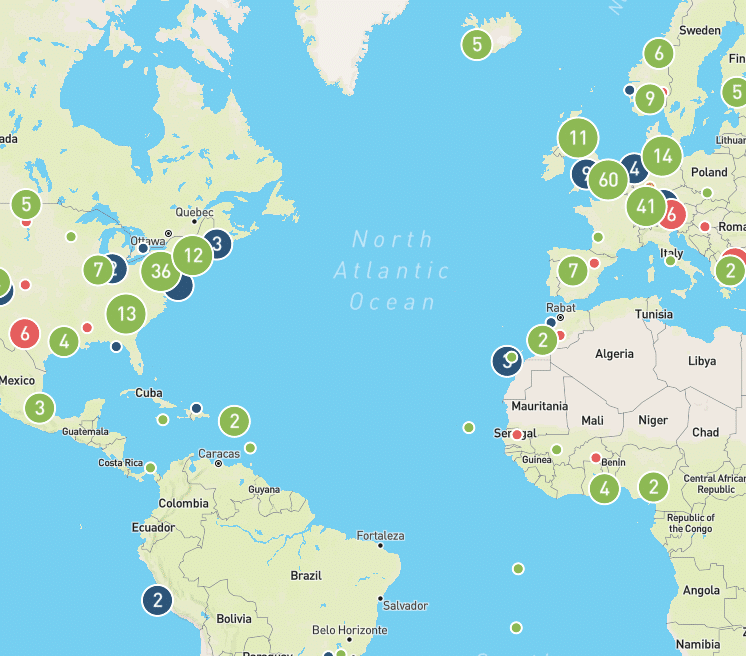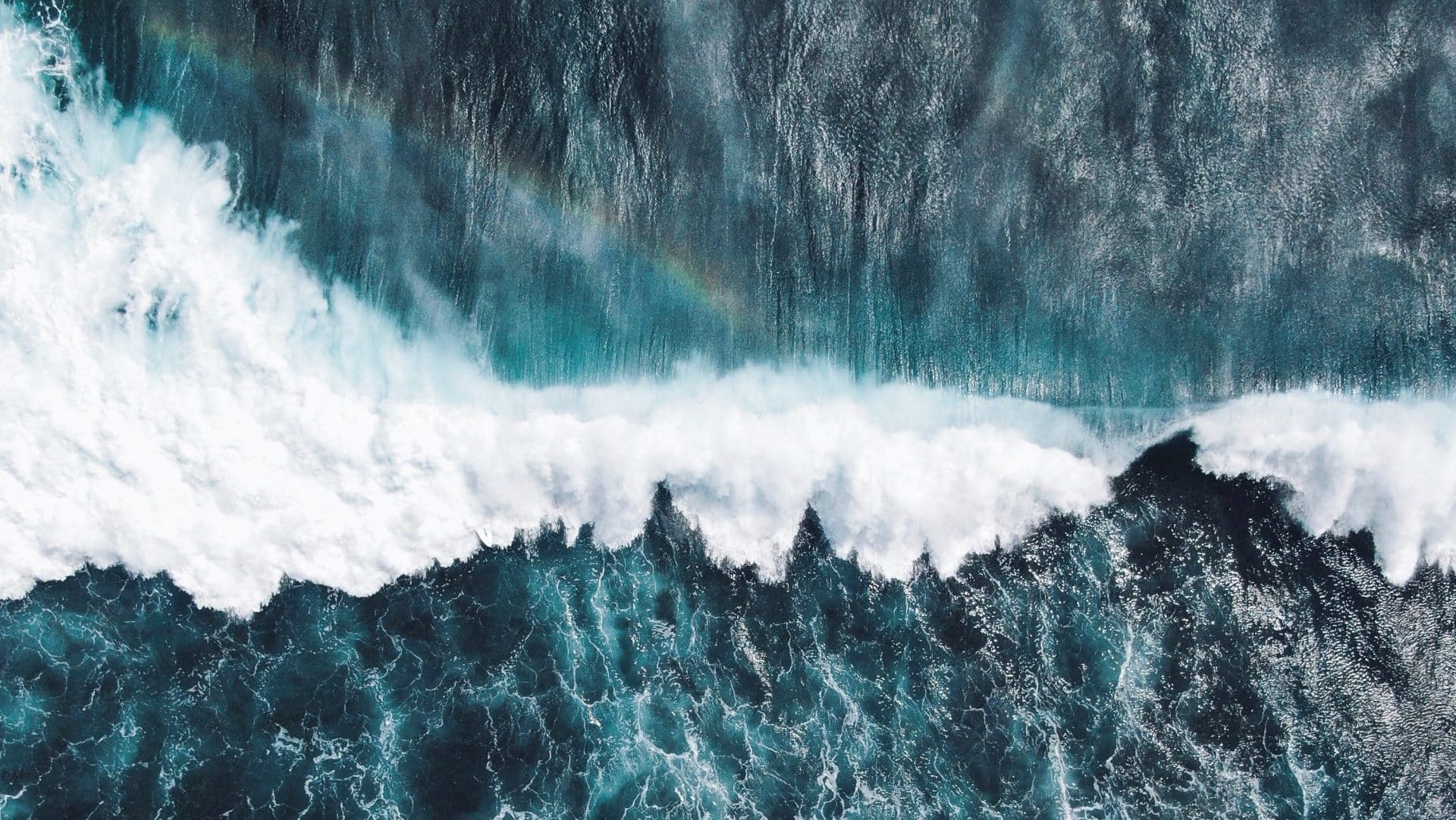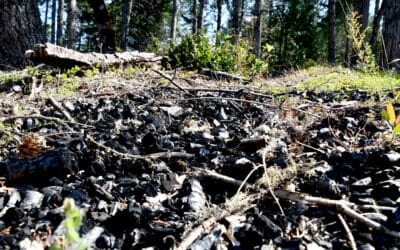This is an extended article of the already published piece in Rundbreif (in German).
Nathan Thanki & Serayna Solanki
Contact: coordinator@handsoffmotherearth.org
In March, the United Nations agreed to a High Seas Treaty aiming to, in the words of Antonio Guterres, “counter the destructive trends facing ocean health, now and for generations to come.” Under the agreement, countries are now legally mandated to ensure the conservation and sustainable use of marine biological diversity in areas beyond their national jurisdiction.
However, not everybody appreciates our oceans as vastly complex and still largely unknown ecosystems, home to ancient and fascinating marine life and critical in the regulation of many of the earth’s systems. Oceans are increasingly, and concerningly, being pitched as tools against global warming – acting as enhanced sinks to draw down CO2, or by increasing the earth’s albedo (a different practice and approach to ‘protecting’ sinks) – which also happen to offer tremendous business opportunities.
The What and Who of Marine Geoengineering
The geoengineering technologies that are being proposed to manipulate our ocean ecosystems and global natural processes come with great risks and uncertainties, as well as with foreseeable adverse impacts on marine ecosystems and human communities. These techniques are currently in their conceptual and early research phase. However, their effectiveness, feasibility and safety are often exaggerated in order to develop more funding and legitimacy for carbon dioxide removal research, often come with a heavy dose of exaggerated claims of efficacy, feasibility and safety – to say nothing of the risk that comes with offering today’s main polluters – the fossil fuel industry – a perfect cover to continue polluting.
Marine geoengineering projects generally fall into one of two broader categories of geoengineering: Solar Radiation Management (SRM) and Carbon Dioxide Removal (CDR).
Ocean Fertilisation (OF) is a prominent CDR technique that involves dumping nutrients into the ocean to stimulate the growth of phytoplankton that will then die and sink to the seafloor, thus ‘sequestering’ carbon in the deep sea. Experiments have failed to prove that OF is effective at actually sequestering carbon. Very few of the theoretical assumptions hold up in reality because the food chain includes bigger creatures feeding on plankton and re-releasing that carbon to the atmosphere. Excess nutrients disrupt the ecological balance, triggering harmful algal blooms and exacerbating ocean acidification. There is broad scientific agreement that OF has negative impacts on the marine food web, artisanal fishers, algae cultivators and the livelihoods of coastal communities.
Recent pushes for OF have come from the Cambridge Centre for Climate Repair (CCRC) which has partnered with India’s Institute of Maritime Studies to conduct testing off the coast of Goa, India in the Arabian Sea. A new geoengineering initiative, the Carbon Removal Partnership led by Arizona State University, names plankton fertilisation a technique for Ocean Restoration. Rogue researcher Russ George is perhaps the most infamous proponent, leading the 2012 ocean fertilization experiment with Haida Salmon Restoration Corporation, and has since revived his research in Alaska and New England under an organisation called Ocean Pasture Restoration. An Elon Musk-funded venture, WhaleX, in partnership with Ocean Nourishment Corporation, is working hard to rebrand ocean fertilization, calling it ‘Artificial Whale Poo’.
Another CDR method is Ocean Alkalization Enhancement (OAE) which attempts to rapidly replicate the process of natural weathering. This involves spreading millions of tonnes of mined minerals along coastal regions, in the oceans and on land to increase ocean alkalinity. OAE requires huge quantities of mined rocks to be milled, transported and dispersed, which comes with a hefty CO2 environmental footprint, huge mineral requirements and likely the violation of rights across its value chain.
An emerging method is the coastal spreading of olivine, through a technique called Enhanced Weathering. There is evidence of significant active interest both in academic circles and by some companies in developing this technique and carrying out field trials. In particular, the company Project Vesta is developing proposals for field trials involving the depositing of olivine minerals on beaches of the Dominican Republic as well as in Southampton Town, New York and other further planned trials. Another method is currently being tested by X-Prize-funded and Canada-based Planetary Technology in St Ives Bay, UK which has been opposed by the local community. For more information about upcoming trials, see the Geoengineering Map.
Marine Cloud Brightening (MCB) – which is both marine geoengineering and solar geoengineering – aims to spray seawater droplets of approximately 100 nm in size (smaller than bacteria) at distances of 1.5-2 km high (2-3 times the height of the tallest building on Earth) in an attempt to increase Earth’s albedo effect. Essentially, thousands of ships would aim to vertically spray seawater droplets at a rate of approximately 50 cubic metres per second over a large portion of Earth’s ocean surface. Depending on where the droplets land, this could even disperse clouds, having the opposite effect – and on a larger scale, has the potential to affect regional and even global weather patterns.
The Australian Government’s AUS$ 150 million Reef Restoration and Adaptation Program has a ‘Cooling and Shading’ sub-program that includes a marine cloud brightening project. Other key actors are the US-based Silverlining, formerly known as the ongoing Marine Cloud Brightening Project. The technique is supported by US billionaire George Soros. The Centre for Climate Repair at Cambridge (CCRC) and Refreeze the Arctic Foundation (RAF) have lately signed a multi-year agreement to fund research methods for brightening clouds to combat climate change. CCRC founder Sir David King, who envisions deployment within 7 years, estimates that a £30-40 billion fleet of 500-1,000 oceangoing vessels, operating at an annual cost of £10 billion, would be needed.
Worryingly, Marine Geoengineering is currently enjoying a surge in both commercial and scientific interest. In the last few years, more consortiums of research institutions are studying how to modify the ocean’s capacity to absorb CO2 or use it as a tool to theoretically reflect sunlight. Such consortiums are based in the Global North, such as the EU-funded OceanNETs project. The German Federal Ministry of Education and Research studies have hurried to conduct two field studies.
In 2022, US National Academy of Sciences (NAS) launched a 10-year research strategy plan on a variety of forms of ocean-based CDR and sequestration costing $125M – approx. $2.4B. This national interest in pursuing research has legitimised the work of US-based Ocean Visions and Running Tide, a non-profit organization with afoot in the Carbon Removal Partnership, Silverlining, and lately had its biennial summit sponsored by the American Geophysical Union.
Resistance
While capitalists see geoengineering as a chance to make money while green-washing their reputations at the prospect of marine geoengineering, communities around the world, especially at the sites of experimentation, are concerned. Past real-world experiments have shown that geoengineering proponents often bypass national policies and regulations or co-opt local communities to execute their plans, so community resistance plays a critical role in opposing geoengineering.
Scientific communities in Latin America have been resisting and lobbying for national governments to enact policies that would protect their oceans in light of the Canadian-based Oceanous attempt to replenish fish stock via OF in 2017. The Terram Foundation, states that “there is a risk that adding iron could produce toxic species that generate red tide. That is why we propose that we must be very cautious and worry about the lack of information.” Terram has also produced scientific reports that highlight the need “to deal with the transnational nature of the effects of marine geoengineering”.
Marine Geoengineering techniques have been opposed by significant alliances in the fishing community. Ahead of COP27, both India’s National Platform for Small-Scale Fish Workers (NPSSFW) and FishNet Alliance, a network of artisanal fishermen across the African continent made clear that they reject Marine Geoengineering as an option to address climate change. The FishNet Alliance have stated that “a continent like Africa, especially coastal communities that already suffer the excruciating and ubiquitous impacts from pollution, coastal erosion, sea level rise, displacements from their traditional fishing grounds, and livelihoods losses amongst other climate and environmental issues, the impacts would be exponential and recovery may become impossible.”
Similar concerns come from India’s NPSSFW, which shares that “it is pertinent to stop using oceans as the greatest sink for waste and pollutants. Polluted seas lose their capacity to sequester carbon. Non-point source pollution, the release of toxic wastes from industries, oil spills, littering and ocean mining are disrupting marine ecosystems. It is far more important to stop ocean pollution and help the oceans in restoring and increasing their capacities to sequester carbon than resorting to false and risky experiments”.
Neth Daño, a Filipina campaigner, led a fight against an ocean fertilization experiment in the Sulu Sea between the Philippines and Malaysia in 2007 when scientists-entrepreneurs from the University of Sydney aimed to sell carbon credits from the project. Working with environmental groups and fisherfolk organisations, Daño helped expose the trials to the media – including a lack of consent from concerned government agencies – and lobbied the Philippine government to take action, which it did, denouncing and shutting down the trial and then strongly supporting an international moratorium on ocean fertilization in the Convention on Biological Diversity (Decision X/33, 2010), considering the risks such activities pose to biodiversity and related social and cultural impacts.
Elsewhere, the idea of “Refreezing the Arctic” has been used to raise funds for marine geoengineering projects. In Alaska, the Arctic Ice Project had attempted experiments which have received opposition from Native Alaskan communities for violation of Free Prior and Informed Consent and called for an end to the research. The Arctic Ice Project uses the technique of Surface Albedo Modification, a form of solar geoengineering, which aims to modify the reflectivity of ice or snow by dumping millions of synthetic silica glass microbeads onto Arctic land or sea ice. In 2020, the Arctic Ice Project rebranded itself from Ice911. Leslie Field, who led most of these experiments with the Arctic Ice Project, has also founded a nearly identical project, called Bright Ice Initiative that aims to conduct testing on the Chhota Shigri Glacier in the Indian Himalayas having lately promoted the technique at the Arctic Circle conference on the ‘Third Pole’ hosted in Abu Dhabi.
Regulation
The International Marine Organisation has regulated marine geoengineering since 1999. In 2009, the country of Vanuatu raised the alarm that ocean fertilization could modify marine ecosystems in uncontrollable ways by inducing changes in the food chain in localised marine biological habitats and would lead to further loss of marine biodiversity. Under the London Convention / London Protocol (LC / LP), the dumping of waste at sea was regulated in a 2010 resolution requiring any research on ocean fertilization to be assessed through provided frameworks and to be sure that any proposed ocean fertilization projects are for scientific – not commercial – purposes.
In 2013, the London Protocol adopted a broader decision to regulate marine geoengineering which, when it comes into force, will provide a legally binding mechanism to regulate ocean fertilization, while also enabling the London Protocol to regulate future marine geoengineering activities that fall within its scope, offering hope for a new regulatory pathway to stop dangerous marine geoengineering projects.
Lately, the London Convention has woken up to proliferating research developments and has stated the need for priority evaluation of the CDR and SRM techniques: enhancing ocean alkalinity (CDR); macroalgae cultivation and other biomass for sequestration including artificial upwelling (CDR); marine cloud brightening (SRM); and microbubbles/reflective particles/material (SRM). The Scientific Groups reporting to the Convention have raised concerns that many marine geoengineering techniques have the potential to cause deleterious effects that are widespread, long-lasting or severe.
However, other international policy spaces such as the UNFCCC undermine these efforts due to their continued insistence on carbon offsets. Rather than tackle the problem at source by restricting fossil fuel production, the UNFCCC opts for more convoluted market-based approaches whereby countries continue to burn fossil fuels and simply “bridge” the gap between this reality and their emissions reduction targets through the purchase of credits which are generated through dubious schemes that claim to avert or remove atmospheric emissions. This is already normalised through what is enhancing “natural sinks” through a suite of technologies including Ocean Fertilisation and Ocean Alkalinity Enhancement.
In a letter, the LC/LP stated that “Parties should apply the generic assessment framework as entailed in Annex 5 of the Amendment of 2013 and should apply utmost caution” to marine geoengineering techniques. Despite this, numerous bodies such as the World Economic Forum, American Geophysical Union and the UK government are trying to establish voluntary ethical frameworks or code of conducts for research, claiming an urgent need for greater research into ocean-based CDR approaches as they are currently under-researched and there are no agreed criteria to guide this research. Despite their intentions to understand more, these frameworks and such research could accelerate governments further down a slippery slope to rely on harmful and unprovable solutions within their national climate commitments.
The LC/LP must be prepared to be critical of external influence on any future code of conduct and strengthen the precedent of its precautionary approach to ocean fertilization. The India National Platform for Small-Scale Fish Workers highlights: “Marine geoengineering merely creates an illusion of progress, an illusion behind which the small-scale fishing communities shall be compelled to continue to bear the brunt of the climate crisis on the one hand, and the big business and corporate will continue to profiteer from the crisis on the other.”
What is to be done?
Worryingly, over 20 marine geoengineering projects are already selling carbon credits on carbon marketplaces when there is little consensus on the ability to Monitor, Verify and Report on the actual carbon removed. Marine Geoengineering is quickly developing as an emerging industry.
This can only be addressed by critical civil society engagement in spaces that have already begun to regulate geoengineering in order to uphold the precautionary principle. Since the 2010 decision on geoengineering in the Convention of Biodiversity, marine geoengineering projects have taken place without governments properly reporting on the experiments. At the latest CBD COP15, over 80 civil society organizations called on CBD COP15 to reinforce precautions against geoengineering to protect biodiversity and communities. We need to build upon and strengthen the collective voice of civil society calling for restriction.
Fundamentally, the pursuit of marine geoengineering, like all forms of geoengineering, is the pursuit of profit with a veneer of concern about climate change. This veneer of a “climate solution” is a stonewall against the opposition. You will be labelled as unambitious merely for pointing out that it is wiser to pursue feasible solutions, energy efficiency, and an equitable phase-out of fossil fuels rather than rely on wishful thinking about future technology saving humanity from the greed of elites. But it is essential to insist on the truth – our unprecedented burning of carbon in the last 200 years through uncontrollable economic growth and consumption is wreaking havoc with the Earth’s systems. More interference in complex ecosystems which we do not fully understand through get-rich-quick schemes based on speculative technologies is the last thing we need.

If you’re interested in knowing more about what Marine Geoengineering projects are planned, on-going, cancelled or on-going – you can find Artificial Upwelling, Enhanced Weathering, Marine Cloud Brightening, Microbubbles/ Sea Foams and Macro Algae projects on the interactive Geoengineering Monitor Map.



